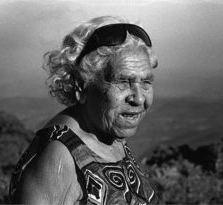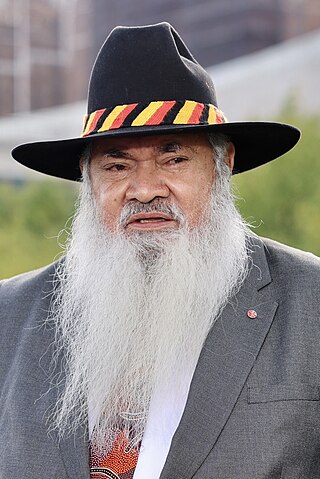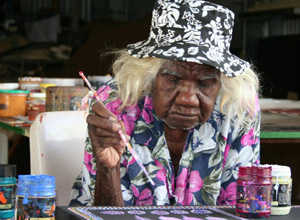Related Research Articles

Broome, also known as Rubibi by the Yawuru people, is a coastal pearling and tourist town in the Kimberley region of Western Australia, 2,046 km (1,271 mi) north of Perth. The town recorded a population of 14,660 in the 2021 census. It is the largest town in the Kimberley region.
The Kimberley is the northernmost of the nine regions of Western Australia. It is bordered on the west by the Indian Ocean, on the north by the Timor Sea, on the south by the Great Sandy and Tanami deserts in the region of the Pilbara, and on the east by the Northern Territory.

Queenie McKenzie (Nakarra) (formerly Oakes, or Mingmarriya) (c. 1915 – 16 November 1998) was an Aboriginal Australian artist. She was born on Old Texas Station, on the western bank of the Ord River in the East Kimberley.

Patrick Lionel Djargun Dodson is an Australian indigenous rights activist and former politician. He was a Senator for Western Australia from 2016 to 2024, representing the Australian Labor Party (ALP).

The Shire of Derby–West Kimberley is one of four local government areas in the Kimberley region of northern Western Australia, covering an area of 104,080 square kilometres (40,186 sq mi), most of which is sparsely populated. The Shire's population as at the 2016 Census was almost 8,000, with most residing in the major towns of Derby, which is also the Shire's seat of government, and Fitzroy Crossing. There are also around 70 Aboriginal communities within the Shire.
Nyikina is an Australian Aboriginal language of Western Australia, spoken by the Nyigina people.
The Djukun are an Aboriginal Australian people of the Kimberley region of Western Australia.

The Shire of Broome is one of the four local government areas in the Kimberley region of northern Western Australia, covering an area of 55,796 square kilometres (21,543 sq mi), most of which is sparsely populated. The Shire's estimated population as at the 2016 census was 16,222 most of whom reside in the town of Broome. Many Aboriginal communities are within the Shire, notably Beagle Bay and Bardi.

The Dampier Peninsula is a peninsula located north of Broome and Roebuck Bay in the Kimberley region of Western Australia. It is surrounded by the Indian Ocean to the west and north, and King Sound to the east. It is named after the mariner and explorer William Dampier who visited it. The northernmost part of the peninsula is Cape Leveque. It is sparsely inhabited, mostly by Indigenous Australian peoples, some of whom have been granted native title rights to some of their traditional lands. There are many coastal inlets, bays and other features, including Beagle Bay on its western side.

Daisy Loongkoonan was an Australian Aboriginal artist and elder from the Nyikina people of the central western Kimberley region in Western Australia. Loongkoonan was born at Mount Anderson near the Fitzroy River. Her parents worked on cattle stations, and as she grew up, Loongkoonan followed them, mustering sheep and cooking in stock camps. Later she rode horses and mustered cattle.
Stephen Muecke is an Australian ethnographer. He is an Emeritus Professor of Ethnography at the University of New South Wales, Australia and adjunct professor at the Nulungu Institute, University of Notre Dame, Broome. He studied linguistics and semiotics, completing his PhD on storytelling techniques among Aboriginal people in Broome, Western Australia.

The Nyikina people are an Aboriginal Australian people of the Kimberley region of Western Australia.
Goolarabooloo Millibinyarri is an Aboriginal community, located 12 km north of Broome in the Kimberley region of Western Australia, within the Shire of Broome.
Jarlmadangah Burru is an Aboriginal community located 86 kilometres (53 mi) southeast of Derby in the Kimberley region of Western Australia, within the Shire of Derby-West Kimberley.
Jimbalakudunj is a small Aboriginal community located approximately 100 kilometres (62 mi) north west of Fitzroy Crossing in the Kimberley region of Western Australia, within the Shire of Derby–West Kimberley.
Bidan is a small Aboriginal community, located 110 km east of Broome in the Kimberley region of Western Australia, within the Shire of Derby-West Kimberley. Bidan occupies a unique location in the West Kimberley settlement pattern in the sense that it is proximate to the midway point between the coastal regional centres of Broome and Derby.
Joe Nangan (1900-1989) was an Aboriginal Australian lawman, jalngunguru and artist. In his role as a custodian of legends, Nangan was responsible for the preservation of the sounds and performances of ceremonial dance and songlines. As an artist, he created hundreds of pencil and watercolour drawings, as well as incised pearl shells and boab nuts, that convey powerful connections to his Country.

Mark Coles Smith, also known as Kalaji, is an Aboriginal Australian actor of stage and screen, sound designer, field recordist, writer, and composer. He is known for his roles in the feature films Last Cab to Darwin (2015), Picnic at Hanging Rock (2018), and Occupation: Rainfall (2020), as well as the television series Mystery Road: Origin (2022), and the Canadian series Hard Rock Medical (2013–18).
Roebuck Plains Station is a pastoral lease that is located close to the township of Broome in the Kimberley region of Western Australia. It is one of the closest pastoral leases to Broome.

Anne Poelina is an Aboriginal Australian community leader, human rights advocate, filmmaker, and academic.
References
Aditional References
1. Maban is the name used by Aboriginal people of the West Kimberley for a man who has access to supernatural powers of one or more ancestral beings of the Dreaming and has been endowed with the ability to utilise those powers in a variety of ways, usually in support of community well-being. The name of the female equivalent is janggungurr. Across Australia, there are a variety of names for ‘maban’ such as karadji, gingin, kurdaitcha and bán-man. Commonly known as a ‘clever man’, a maban is also referred to in the literature as a ‘medicine man’ or ‘doctor’ though their functions are much broader. In the Americas, Siberia and other places, the equivalent is a shaman.
2. Ethnologist Dr Helmut Petri, leader of the 1938 German Frobenius expedition to the Kimberley, wrote of Joe Nangan, “From his earliest youth he had been regarded in the whole northwest as a maban wánggu-djáding, a medicine man of the first rank”.
See Pawsey, M. (trans.) & Akerman, K. (ed.) 2015 Cologne to the Kimberley – Studies of Aboriginal Life in Northwest Australia by Five German Scholars in the First Half of the 20th Century. Carlisle, Western Australia: Hesperian Press.
3. Where the word ‘Country’ is capitalised its meaning encompasses not only the countryside but all material and non-material elements of earth, waters and sky and their cultural implications. In essence, Country is the entire natural world (visible and invisible), often referred to by the First Peoples as ‘living Country’.
4. https://aiatsis.gov.au/explore/stolen-generations
5. Kim Akerman. 1974. Aboriginal Camp Sites On The Western Coast Of Dampier Land, Western Australia. The 12-paper can be viewed at: www.parliament.wa.gov.au/publications/tabledpapers.nsf/displaypaper/3814927c9205b6 6b7f2d21b648257a790009255f/$file/4927.pdf
6. Akerman, K. 1976. Notes on the experimental manufacture of long blades and points by percussion flaking. Occasional Papers in Anthropology. Anthropology Museum University of Queensland. 6: 117-28.
Akerman, K., 1981. Horde areas and mythological sites between James Price Point and Coconut Well on the west coast of Dampierland, WA. Broome: Kimberley Land Council.
Akerman, K., & Bindon, P. 1983. Evidence of Aboriginal lithic experimentation on the Dampierland Peninsula, in Smith, M. (ed.) Archaeology at ANZAAS 1983. Perth: Western Australian Museum, pp. 75- 80.
7. https://en.wikipedia.org/wiki/Patricia_Vinnicombe
Also, see p.466 of Total Reset: Realigning with our timeless holistic blueprint for living. 2023, by Greg Campbell with Lulu and the Goolarabooloo People. Dunsborough, Western Australia: Total Reset.
8. The Goolarabooloo Millibinyarri Indigenous Corporation (GMIC) is a body incorporated under the Australian Corporations (Aboriginal and Torres Strait Islander) Act 2006. The name ‘Millibinyarrri’ refers to Aboriginal land in the Coconut Well area, 24 km north of Broome. The name ‘Goolarabooloo’ (Goolara = west coast/sundown/seaside; booloo = people/place) is both a generic name for saltwater societies of the West Kimberley region of Western Australia and the name of the community whose apical ancestors are Paddy Roe and his wife Mary Pikalili. In her 1899-1902 fieldwork, Daisy Bates called them the Koolarrbulloo and the Koolarabooloo. In his 1940s work, archaeologist- anthropologist Norman Tindale referred to the Goolarabooloo as the Kularapulu. The Goolarabooloo people include members of the saltwater communities of the West Kimberley: Bardi-Jawi, Nimanburr, Nyul Nyul, Jabbirjabbir, Ngumbarl, Djukun and Karajarri plus non-Indigenous people.
9. https://www.goolarabooloo.org.au/lurujarri.html Publications providing descriptions of the Lurujarri Heritage Trail include:
Total Reset: Realigning with our timeless holistic blueprint for living. 2023, by Greg Campbell with Lulu and the Goolarabooloo People. Dunsborough, Western Australia, Ch.29, pp.436-54
The Children’s Country: Creation of a Goolarabooloo Future Future in North-West Australia. 2020, by Stephen Muecke & Paddy Roe. London: Rowman & Littlefield.
Stranger Country. 2019, by Monica Tan, Crows Nest, Sydney: Allen & Unwin, pp133-75.
Being with Country: The performance of people–place relationships on The Lurujarri Dreaming Trail, (PhD). 2016, by Ourania Emmanouil. Charles Darwin University, Northern Territory. It can be viewed at: https://ris.cdu.edu.au/ws/portalfiles/portal/33354486/Thesis_CDU_60267_Emmanouil_O.pdf
Protecting the Songlines, 2015. Episode 6 in a Canadian documentary Native Planet series, hosted by acclaimed First Nations actor Simon Baker. It focuses on the Goolarabooloo people. https://nativeplanet.tv/episode/protecting-the-song-lines/
10. Mining Warden’s court hearing in Broome 22-25 July 1991 in relation to Objections Nos 1-5/890, 18/890 and 3-4/901 to Applications by Terrex Resources NL for Exploration licenses EO4/645, 646 & 647: findings of 20 August 1991 by the warden, Dr JA Howard SM, available at the WA Department of Mines’ list of Warden’s Court decisions for 1991, Vol 8, Folio 8AA. www.dmp.wa.gov.au/Documents/Wardens- Court/Vol08_FOLIO08AA.pdf# <viewed 6 December 2024>
11. Like the millions of other species on planet Earth, homo sapiens is inextricably part of the natural world and under its law. Some refer to it as Earth Law or Natural Law. For Indigenous Australians, it is First Law, telling how the non-human-created laws of the universe operate for our species. So long as any species is aligned with its Law it fulfils its purpose in the scheme of things, maximising the prospects of its continuance and that of the whole system. Non-aligned, extinction awaits.
12. Bradshaw, E. & Fry, R. 1989. A Management Report for the Lurujarri Heritage Trail, Broome, Western Australia. Perth: Department of Aboriginal Sites, Western Australian Museum. https://library.museum.wa.gov.au/fullRecord.jsp?recnoListAttr=recnoList&recno=63175
13. http://www1.rmit.edu.au/courses/014736
14. Jim Sinatra and Phin Murphy, Listen to the People, Listen to the Land. 1999. Melbourne: Melbourne University Press. The 1 st chapter, Black and White, a trail to understanding (pp.11-30), shares perspectives of Lulu and the Goolarabooloo people.
15. Medal of the Order of Australia (OAM) awarded to Paddy Roe for service to Aboriginal welfare. https://trove.nla.gov.au/newspaper/article/120874672
16. Paddy Roe (Stephen Muecke editor), Gularabulu: Stories from the West Kimberley. 1983. South Fremantle: Fremantle Arts Centre Press. The book won the 1985 Western Australian Week Literary Award. Krim Benterrak, Stephen Muecke and Paddy Roe, Reading the Country: Introduction to Nomadology. 1984. Revised edition1996 by Fremantle Arts Centre Press; 2014 edition by re.Press
17. Ray Aitchison, on behalf of the National Library of Australia. May 1986. Audio recording of a 90-minute interview with Lulu. https://catalogue.nla.gov.au/Record/126350 An edited transcript of a portion of this interview (from the 38:09 to the 46:40-minute mark) is available at www.totalreset.com.au, under ‘Storytelling’ on the ‘About Total Reset’ page. Liz Thompson (compiler). 1990. Aboriginal Voices: Contemporary Aboriginal artists, writers and performers. Australia: Simon & Schuster. Lulu is one of 31 respected Aboriginal writers, painters, dancers and storytellers from western, central and eastern Australia featured. https://www.amazon.com.au/Aboriginal-Voices-Contemporary-Artists- Performers/dp/1876622040
18. Total Reset: Realigning with our timeless holistic blueprint for living, by Greg Campbell with Lulu and the Goolarabooloo Family. 2022 & 2023 (1st ed. rev.), Dunsborough, WA. The printed book and the 2023 audiobook by Mark Coles Smith can be previewed and are available at www.totalreset.com.au Part 2 (1st ed. rev., pp.143-436) contains a comprehensive account of the stories and deep knowledge of Lulu and the Goolarabooloo people.
19. The audiobook can be sampled and is available at www.totalreset.com.au
20. Total Reset, op.cit., p.xi
21. Maybury-Lewis, David. 1992. Millennium: Tribal Wisdom and the Modern World. New York: Viking
22. Inventing Reality, 6 th video in the 10-video series Millennium: Tribal Wisdom and the Modern World. www.youtube.com/watch?v=PGZK0v3JaEo/ (Lulu and Goolarabooloo people are featured from the 38:30-55.28-minute mark)
23. Senator Aden Ridgeway’s full speech can be read in the Parliament of Australia’s Hansard (Senate) transcript of 20 August 2001. https://parlinfo.aph.gov.au/parlInfo/search/search.w3p;adv=yes;orderBy=_fragment_number, doc_date-rev
24. Murray Wilcox QC (compiler). 2010. Kimberley At The Crossroads – the case against the gas plant. Broome: Save The Kimberley P/L. The full-colour PDF version is accessible at https://www.savethekimberley.com/2012/09/19/kimberley-at-the- crossroads-pdf-now-available/
Eugénie Dumont. 2014. Heritage Fight. Keystone Films presentation of a 90-minute documentary. The trailer can be viewed at https://en.unifrance.org/movie/38380/heritage-fight
Damian Kelly. 2016. James Price Point: the story of a movement. Broome: Damian Kelly Photography Peter Botsman. 2012. Law Below the Top Soil. Broome: Save The Kimberley P/L
25. Total Reset: Realigning with our timeless holistic blueprint for living, op.cit., pp.456-521
26. Ibid, p.x